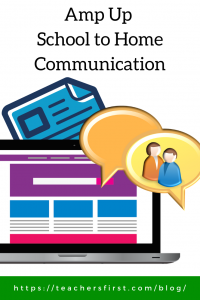 A new year is a time for reflection and resolutions. Perhaps you have taken the time to reflect upon your teaching and want to make some changes. One area all teachers should think about is how well they effectively communicate with parents and family members as part of their ongoing efforts to make all students successful.
A new year is a time for reflection and resolutions. Perhaps you have taken the time to reflect upon your teaching and want to make some changes. One area all teachers should think about is how well they effectively communicate with parents and family members as part of their ongoing efforts to make all students successful.
This NEA Policy brief makes it clear that research is comprehensive, consistent, and convincing that parent, family, and community involvement leads to greater academic success. This success relates to students’ not only achieving higher grades, but also to regular school attendance, participation in higher-level educational programs, and more.
Additional research provides information on the best way to achieve school to home communication. This infographic from the Speak Up Research Initiative reveals some interesting differences in the perception of effective communication between parents and principals. Principals indicate their belief that face-to-face meetings provide the most effective communication, while parents prefer individual emails or automated phone messages.
A couple of years ago, I shared some Practical (and easy) Tips for Communicating with Parents. That blog post contains several online tools and classroom suggestions to use for parent communication. All of those ideas remain valid suggestions for staying in touch with family members; here are some more ideas to help you build support for your classroom through ongoing interactions with parents and families.
Communication Tips:
Build 2-way communication by inviting parents to share their knowledge with students. Flipgrid (TeachersFirst review) is a video response tool that encourages collaboration between users. The infographic mentioned earlier indicates that parents prefer methods of communication that are short and available when they have the opportunity to read and respond. Flipgrid fits right into those categories due to its convenience of use across devices and 24-hour availability. Use Flipgrid to post a question for parent responses. Here are some ideas to get you started:
- When teaching a unit on careers, ask parents to share information about their job. Invite them to discuss the training needed to do their job, what they do each day, and how they ended up in that career.
- Another idea is to post a math problem and have parents share how they solve it. Use these videos in the classroom to help students understand different problem-solving methods.
- Ask parents to share a favorite book from their childhood and their memories of reading books as a youngster. Try to find their books at the library and share them with your students. Even better, ask the parent to come into your class and read to your students.
- Search Flipgrid for excellent ideas for building rapport with parents. This topic is for use with parent/teacher conferences and was a big hit with parents. Students share what they learn, challenges, successes, and ideas for how parents can support them for the remainder of the year in biology. The author said, “I had all of my students do this the day before parent-teacher conferences. On conference day, I let the parents watch the video to gain insight into what their child is learning. Parents loved it! “
Implement an ongoing video series or podcast demonstrating content being taught or sharing information about your classroom. Once information is online, it is available to parents to view or listen at their leisure instead of having to attend a meeting at a specific place and time. Screencast-o-Matic (TeachersFirst review) creates video recordings of your computer screen for you to upload to YouTube or directly onto your class website. Buzzsprout (TeachersFirst review) offers free podcast hosting.
- If you teach math, you know that parents are sometimes confused about the methods and procedures taught in class. Make a screencast to demonstrate the different strategies used when solving problems and also take the time to discuss how students’ understanding of different math strategies leads to a better understanding of math concepts.
- Make short podcasts each week to share the learning taking place. Invite students to participate with their thoughts of the week, or have older students produce and create podcasts.
- Share a screencast demonstrating how to use new software or navigate a website. Having this information available at home makes it easier for students and parents to understand classroom and/or homework expectations.
- Encourage others at your school to make a school podcast. Each week feature a different staff member, share an upcoming event, or discuss school-wide initiatives.
As you think about improving school to home communication, it is essential to keep a couple of things in mind based on the research discussed earlier. First, try to keep all information as concise as possible. Second, select communication methods that fit into parents’ busy schedules and are available when they are ready to view or listen.
Have you made changes to how you communicate with parents and families? Maybe you tried some of the methods discussed in the blog. If so, we would love to hear from you. Share your thoughts in the comments below.

